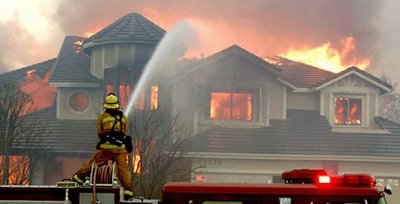The air tanker base that the U.S. Forest Service recently downgraded to a part-time “call when needed” base set a new national record last Friday for the most fire retardant pumped in a single day–158,000 gallons, according to an article in the Santa Barbara Independent by Nick Welsh.
Wildfire Today covered the issues surrounding the downgrading of the base in an article on May 12, one on May 2, and another one April 10.
Except for reloading three air tankers, the base at Santa Maria, California was not used on the first day of the Jesusita fire after it was discovered that the U.S. Forest Service had not renewed the contract with the supplier of retardant. Since they could not use the closest base, Santa Maria, every time the tankers needed to reload they had to fly an additional 120 miles round trip to Porterville. This also required that they be refueled more frequently, lengthening their turn-around time.
The USFS usually has a contract in effect at the base from May 15 through November 15 and when the Jesusita fire started on May 6 they hadn’t gotten around to it yet. But even if the standard contract had been in place, it would not have been in effect the day the fire started. By the second day of the fire a new contract had been negotiated, effective on May 7, leading to the record-setting use of retardant.
Here is a brief excerpt from Mr. Welsh’s article.
Could the Little Baby Jesus Fire have been bottled up the first day with more drops? Who knows.
In hindsight, Santa Maria would have allowed more and quicker drops, and that undeniably helps. But those in the biz also insist that air tankers don’t put out fires. Instead, air tankers give fire crews the cover they need to put them out. Given the steepness and inaccessibility of the terrain where the fire started — and the conspicuous lack of escape routes — no commanders in their right mind would have allowed firefighters on the ground that first day. Besides, they note, Jesusita spread fewer than 100 acres in that time.
Regardless, the Forest Service contract department needs to figure out that fire season is a 365-day-a-year reality out here, and renew its contracts accordingly.
Amy Asman of the San Luis Obispo, CA NewTime has also written an article about the issue. Here is an excerpt:
…However, Andrew Madsen, public communications specialist for Los Padres National Forest, said [not using Santa Maria on the first day of the fire] didn’t impede the Forest Service’s ability to fight the fire.
“To link the burning fire with the base is Santa Maria is wrong,” Madsen said. “It’s completely inaccurate, and it’s incendiary to people who were victims of the fire.”
The Santa Maria firebase, he said, was “up and running” within the required amount of time, that is, the first 24 hours of the fire. Before that time period ended, the planes carrying fire retardant couldn’t have been used anyway, he explained, because the 100-acre fire was burning in a location inaccessible to on-ground firefighting forces.
“Air support must be used in conjunction with firefighting from the ground,” Madsen said. “Fire retardant drops must be followed immediately by fire fighting from the ground or else they’re moot.”
And after the first 24 hours, Madsen added, the planes still couldn’t be used because of high-speed winds.
“Thirty- to 40 mph winds will ground aircraft every single time,” he said. “Without the winds, that fire wouldn’t have done anything.”
When asked why the Forest Service didn’t have its contract finalized sooner, Madsen said: “Even if we did, it would have been set for [fire season] May 15 to Nov. 15, so we would have had to set up an emergency contract anyway.”
Still, some community members are using the glitch as an example of why the Santa Maria firebase should be restored to full-time status.
“It’s unfortunate what happened, but it validates the need and the ability of the Santa Maria firebase to support an initial fire attack,” Central Coast Jet Center’s Kunkle said.
It is time for the U.S. Forest Service to admit they made mistakes by downgrading the base and by not having the retardant contract in effect before May 15–then they can move on. Until they do, this debate will fester and they will continue to look like fools, having to constantly defend an undefendable position.





